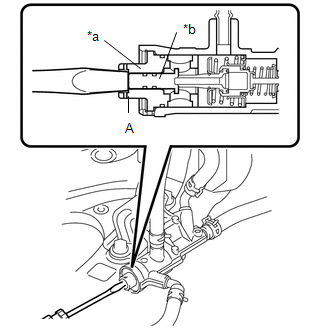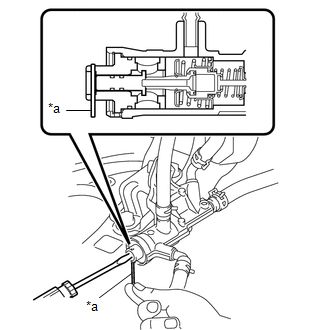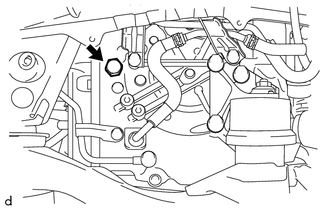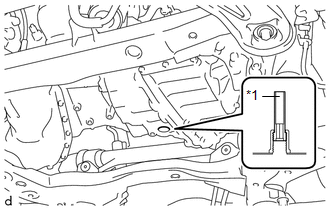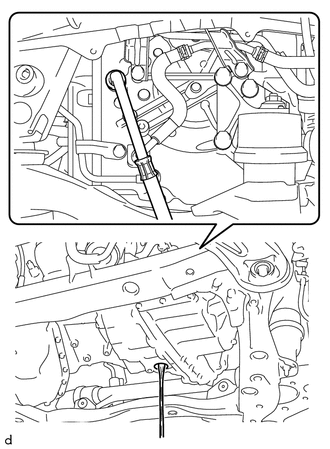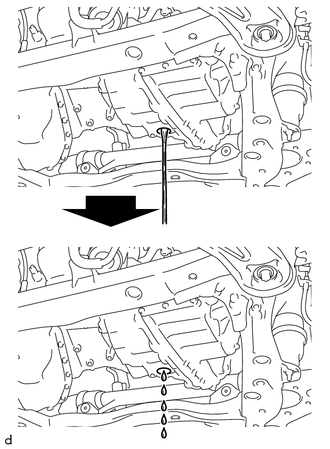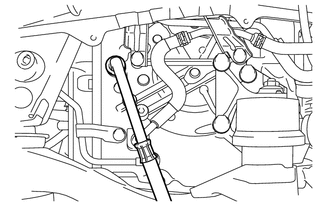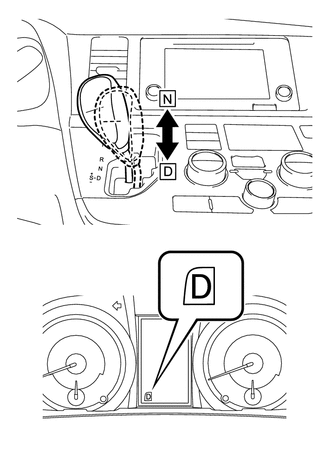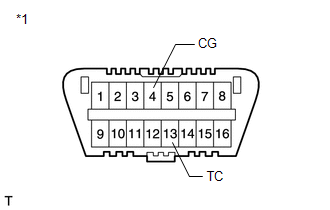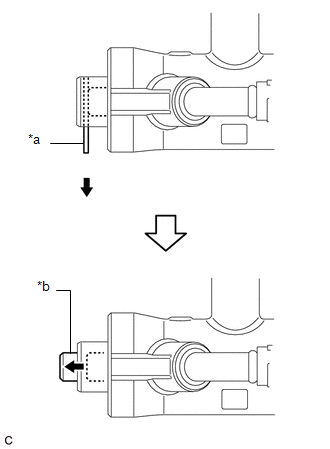- Disconnection of an transmission oil cooler, oil cooler assembly or oil cooler hose
- Repair of an automatic transaxle fluid leak due to a loose case plug, or a faulty plug gasket or O-ring
- Replace of the automatic transaxle assembly
| Last Modified: 08-28-2024 | 6.11:8.1.0 | Doc ID: RM10000000105GO |
| Model Year Start: 2017 | Model: Sienna | Prod Date Range: [08/2016 - ] |
| Title: UA80F (AUTOMATIC TRANSMISSION / TRANSAXLE): AUTOMATIC TRANSAXLE FLUID: ADJUSTMENT; 2017 - 2020 MY Sienna [08/2016 - ] | ||
ADJUSTMENT
PROCEDURE
1. PRECAUTIONS AND WORK DESCRIPTION
(a) The UA80F automatic transaxle assembly does not have an oil filler tube and oil level gauge. When adding automatic transaxle fluid, add automatic transaxle fluid through the refill hole on the automatic transaxle case sub-assembly. The automatic transaxle fluid level can be adjusted by draining excess automatic transaxle fluid (allowing excess automatic transaxle fluid to overflow) through the overflow plug of the transaxle housing.
HINT:
"Overflow" indicates the condition under which automatic transaxle fluid comes out of the overflow plug hole.
(b) Before adjusting the automatic transaxle fluid level, add the specified amount of automatic transaxle fluid when the engine is cold and warm up the engine to circulate the automatic transaxle fluid in the automatic transaxle assembly. Ensure that the automatic transaxle fluid temperature is as specified and the engine is idling.
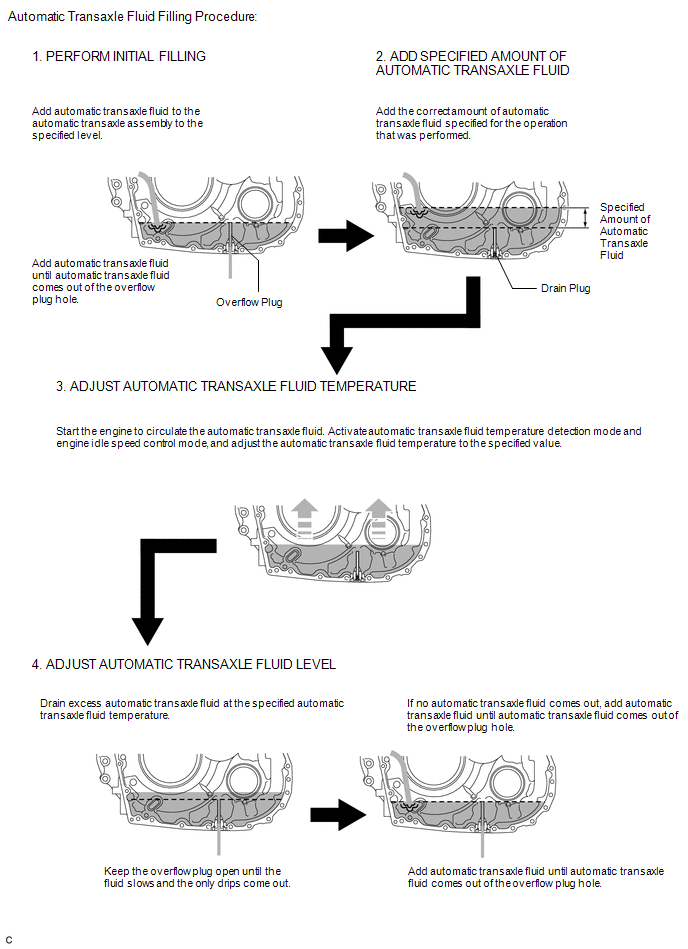
(c) The UA80F automatic transaxle assembly requires Toyota Genuine ATF WS.
(d) The adjustment should be performed according to the procedures and notes.
2. WORK FLOW
(a) The adjustment should be performed according to the procedure referenced in the work flow below.
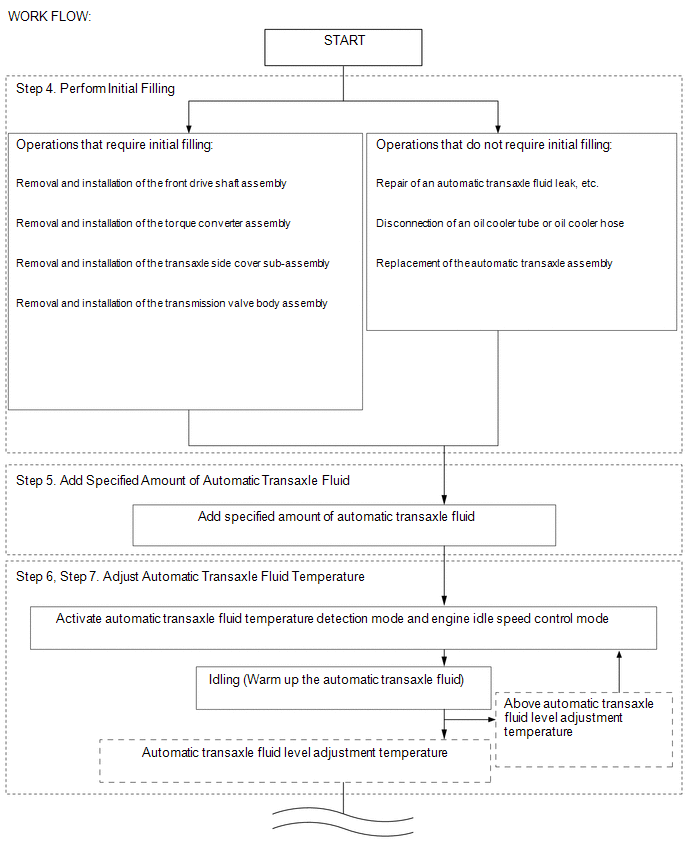
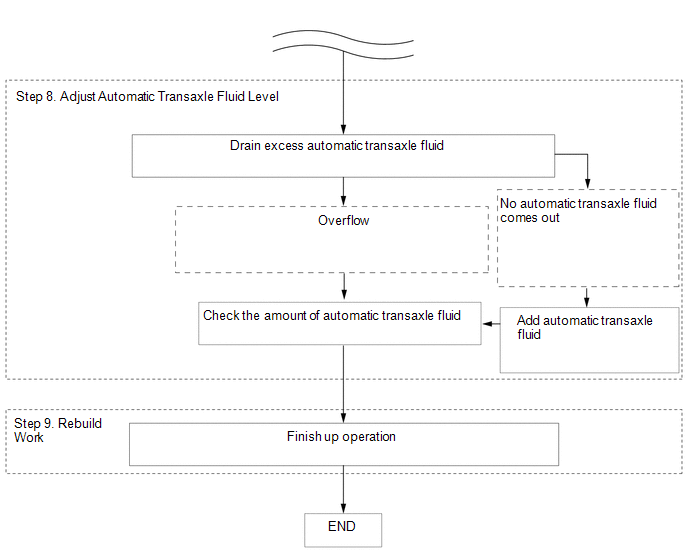
3. PREPARATION WORK
(a) Lift the vehicle.
NOTICE:
Set the vehicle on a lift so that the vehicle is kept level when it is lifted up (make sure that the tilt angle from the front to rear of the vehicle is within +/- 1°).
(b) Remove the No. 1 engine under cover.
(c) Remove the No. 2 engine under cover.
(d) Remove the front fender apron seal LH.
(e) Using compressed air, clean the cap of the transmission oil thermostat.
|
(f) Using a screwdriver, push in the shaft of the transmission oil thermostat. HINT:
|
|
|
(g) With the shaft of the transmission oil thermostat pushed in, insert a pin into a hole on the side of the cap. Insert the pin until it passes through the hole on the other side of the cap to secure the shaft. HINT: Make sure to use a pin with a length of 30 mm (1.18 in.) or more and a diameter of 1.5 mm (0.0591 in.). |
|
4. PERFORM INITIAL FILLING
NOTICE:
If the automatic transaxle assembly is hot (ATF temperature is high), wait until the automatic transaxle fluid temperature becomes the same as the ambient temperature before starting the following procedure. (Recommended ATF temperature: around 20°C [68°F])
|
(a) Remove the refill plug and gasket from the automatic transaxle case sub-assembly. NOTICE: After performing either of the following operations, it is not necessary to perform the initial filling procedure. Proceed to the "Add Specified Amount of Automatic Transaxle Fluid" procedure.
|
|
|
(b) Using a 10 mm hexagon socket wrench, remove the overflow plug and gasket from the transaxle housing. NOTICE:
|
|
|
(c) Using a 6 mm hexagon socket wrench, check that the No. 1 transmission oil filler tube is tightened to the specified torque. Torque: 1.7 N·m {17 kgf·cm, 15 in·lbf} NOTICE: If the No. 1 transmission oil filler tube is not tightened to the specified torque, the amount of automatic transaxle fluid cannot be precisely adjusted. HINT: To check the torque of the No. 1 transmission oil filler tube, insert the 6 mm hexagon socket wrench into the overflow plug hole. |
|
(d) Perform initial filling.
|
(1) Fill the automatic transaxle assembly through the refill hole until automatic transaxle fluid begins to come out of the overflow plug hole. NOTICE: Use Toyota Genuine ATF WS. |
|
|
(e) Wait until the automatic transaxle fluid flow slows and only drips come out. |
|
|
(f) Using a 10 mm hexagon socket wrench, temporarily install the gasket and overflow plug to the transaxle housing. HINT: Reuse the old gasket as the overflow plug will be removed again to adjust the automatic transaxle fluid level. |
|
|
(g) Temporarily install the gasket and refill plug to the automatic transaxle case sub-assembly. HINT: Reuse the old gasket as the refill plug will be removed again to adjust the automatic transaxle fluid level. |
|
5. ADD SPECIFIED AMOUNT OF AUTOMATIC TRANSAXLE FLUID
|
(a) Remove the refill plug and gasket from the automatic transaxle case sub-assembly. |
|
|
(b) Fill the automatic transaxle assembly with the correct amount of automatic transaxle fluid as listed in the table below. NOTICE: Use Toyota Genuine ATF WS. HINT: The refill amount differs depending on the operation that was performed. Reference Capacity:
|
|
|
(c) Temporarily install the gasket and refill plug to avoid automatic transaxle fluid spillage. HINT: Reuse the old gasket as the refill plug will be removed again to adjust the automatic transaxle fluid level. |
|
(d) Lower the vehicle.
6. ADJUST AUTOMATIC TRANSAXLE FLUID TEMPERATURE (when Using the Techstream)
HINT:
The actual ATF temperature can be checked on the Data List using the Techstream.
(a) Connect the Techstream to the DLC3 with the ignition switch off.
(b) Turn the ignition switch ON and turn the Techstream on.
NOTICE:
To reduce load, make sure that all electrical systems, such as the air conditioning, lighting system, electric fan and audio system, are off.
(c) Enter the following menus: Powertrain / Transmission / Active Test / Activate the TC Terminal
Powertrain > Transmission > Active Test
|
Active Test Display |
|---|
|
Activate the TC Terminal |
|
Data List Display |
|---|
|
A/T Oil Temperature No.1 |
(d) According to the display on the Techstream, perform the Data List "A/T Oil Temperature No. 1".
(e) According to the display on the Techstream, perform the Active Test "Activate the TC Terminal / ON".
(f) Check the ATF temperature.
NOTICE:
- If the automatic transaxle fluid temperature is below 45°C (113°F), proceed to the next step. Recommended ATF temperature: 35°C (95°F) or less
- If the automatic transaxle fluid temperature is 45°C (113°F) or more, turn the ignition switch off and wait until the automatic transaxle fluid temperature drops below 45°C (113°F).
(g) Depress and hold the brake pedal.
(h) Start the engine.
(i) Slowly move the shift lever from P to D, then back to P (keep the shift lever in each position for approximately 3 seconds).
HINT:
Slowly move the shift lever to circulate the automatic transaxle fluid through each part of the automatic transaxle assembly.
|
(j) While observing the D shift indicator on the combination meter, move the shift lever back and forth between N and D at an interval of less than 1.5 seconds for 6 seconds or more. NOTICE: Do not pause for more than 1.5 seconds. HINT: Performing this operation will cause the vehicle to enter automatic transaxle fluid temperature detection mode. |
|
(k) Check that the D shift indicator comes on for 2 seconds.
HINT:
- When automatic transaxle fluid temperature detection mode is activated, the D shift indicator on the combination meter comes on for 2 seconds.
- If the D shift indicator does not come on for 2 seconds, return to the first step (perform the Active Test "Activate the TC Terminal / ON") and perform the procedure again.
(l) Move the shift lever to P.
(m) Release the brake pedal.
(n) According to the display on the Techstream, perform the Active Test "Activate the TC Terminal / OFF".
NOTICE:
Make sure that the terminals are not connected. If the terminals are connected, the automatic transaxle fluid level cannot be precisely adjusted due to fluctuations in engine speed.
HINT:
- Disconnecting the terminals activates engine idle speed control mode.
- In engine idle speed control mode, engine idle speed control starts when the automatic transaxle fluid temperature reaches the specified temperature and the engine speed is maintained.
- Even after the terminals are disconnected, automatic transaxle fluid temperature detection mode is active until the ignition switch is turned off.
(o) Adjust the automatic transaxle fluid temperature to the automatic transaxle fluid level adjustment temperature.
Automatic Transaxle Oil Temperature
|
Below Automatic Transaxle Fluid Level Adjustment Temperature |
Automatic Transaxle Fluid Level Adjustment Temperature |
Above Automatic Transaxle Fluid Level Adjustment Temperature |
|
35°C or less (95°F or less) |
35 to 45°C (95 to 113°F) |
45°C or more (113°F or more) |
NOTICE:
- If the automatic transaxle fluid temperature is within the automatic transaxle fluid level adjustment temperature range, immediately proceed to the "Adjust Fluid Level" procedure.
- If the automatic transaxle fluid temperature is 45°C (113°F) or more, stop the engine and wait until the automatic transaxle fluid temperature drops to 35°C (95°F) or less. Then perform the "Adjust Automatic Transaxle Fluid Temperature" procedure again from the beginning.
HINT:
In automatic transaxle fluid temperature detection mode, the D shift indicator comes on, goes off or blinks depending on the automatic transaxle fluid temperature.
D Shift Indicator
|
Below Automatic Transaxle Fluid Level Adjustment Temperature (35°C or less) (95°F or less) |
Automatic Transaxle Fluid Level Adjustment Temperature (35 to 45°C) (95 to 113°F) |
Above Automatic Transaxle Fluid Level Adjustment Temperature (45°C or more) (113°F or more) |
|
OFF |
ON |
Blinks |
7. ADJUST AUTOMATIC TRANSAXLE FLUID TEMPERATURE (when Not Using the Techstream)
|
(a) Using SST, connect terminals 13 (TC) and 4 (CG) of the DLC3 with the ignition switch off. SST: 09843-18040 |
|
(b) Depress and hold the brake pedal.
(c) Start the engine.
NOTICE:
To reduce load, make sure that all electrical systems, such as the air conditioning, lighting system, electric fan and audio system, are off.
(d) Slowly move the shift lever from P to D, then back to P (keep the shift lever in each position for approximately 3 seconds).
HINT:
Slowly move the shift lever to circulate the automatic transaxle fluid through each part of the automatic transaxle assembly.
|
(e) While observing the D shift indicator on the combination meter, move the shift lever back and forth between N and D at an interval of less than 1.5 seconds for 6 seconds or more. NOTICE: Do not pause for more than 1.5 seconds. HINT: Performing this operation will cause the vehicle to enter automatic transaxle fluid temperature detection mode. |
|
(f) Check that the D shift indicator comes on for 2 seconds.
HINT:
- When automatic transaxle fluid temperature detection mode is activated, the D shift indicator on the combination meter comes on for 2 seconds.
- If the D shift indicator does not come on for 2 seconds, return to the first step (connect terminals 13 (TC) and 4 (CG) of the DLC3) and perform the procedure again.
(g) Move the shift lever from N to P.
(h) Release the brake pedal.
(i) Remove SST from terminals 13 (TC) and 4 (CG).
SST: 09843-18040
NOTICE:
Make sure that the terminals are not connected. If the terminals are connected, the automatic transaxle fluid level cannot be precisely adjusted due to fluctuations in engine speed.
HINT:
- Disconnecting the terminals activates engine idle speed control mode.
- In engine idle speed control mode, engine idle speed control starts when the automatic transaxle fluid temperature reaches the specified temperature and the engine speed is maintained.
- Even after the terminals are disconnected, automatic transaxle fluid temperature detection mode is active until the ignition switch is turned off.
(j) Allow the engine to idle until the D shift indicator comes on again.
D Shift Indicator
|
Below Automatic Transaxle Fluid Level Adjustment Temperature (35°C or less) (95°F or less) |
Automatic Transaxle Fluid Level Adjustment Temperature (35 to 45°C) (95 to 113°F) |
Above Automatic Transaxle Fluid Level Adjustment Temperature (45°C or more) (113°F or more) |
|
OFF |
ON |
Blinks |
NOTICE:
- If the D shift indicator is on, immediately proceed to the "Adjust Automatic Transaxle Fluid Level" procedure.
- If the D shift indicator blinks, stop the engine and wait until the automatic transaxle fluid temperature drops to 35°C (95°F) or less (the indicator goes off). Then perform the "Adjust Automatic Transaxle Fluid Temperature" procedure again from the beginning.
HINT:
- In automatic transaxle fluid temperature detection mode, the D shift indicator comes on, goes off, or blinks depending on the automatic transaxle fluid temperature.
- Automatic transaxle fluid filling procedure should be performed when the D shift indicator is on (the automatic transaxle fluid temperature is within the automatic transaxle fluid level adjustment temperature range).
8. ADJUST AUTOMATIC TRANSAXLE FLUID LEVEL
CAUTION:
Use caution while the engine is idling and the radiator fans are operating.
(a) Lift the vehicle.
NOTICE:
Set the vehicle on a lift so that the vehicle is kept level when it is lifted up (make sure the tilt angle from the front to rear of the vehicle is within +/- 1°).
|
(b) Using a 10 mm hexagon socket wrench, remove the overflow plug and gasket from the transaxle housing. CAUTION: Be careful as the automatic transaxle fluid coming out of the overflow plug hole is hot. |
|
(c) Check the amount of automatic transaxle fluid that comes out of the overflow plug hole.
- If the amount of automatic transaxle fluid that comes out of the overflow plug hole is large, proceed to step [#1].
- If no automatic transaxle fluid comes out of the overflow plug hole, proceed to step [#2].
NOTICE:
If only a small amount of automatic transaxle fluid (approximately 1 cc) comes out of the overflow plug hole, then only automatic transaxle fluid remaining in the No. 1 transmission oil filler tube has come out. This condition is not considered as overflow, so it is necessary to add automatic transaxle fluid.
(d) If the amount of automatic transaxle fluid that comes out of the overflow plug hole is large. [#1]
|
(1) Wait until the automatic transaxle fluid flow slows and only drips come out. HINT: The automatic transaxle fluid flow will not stop completely because the automatic transaxle fluid continues to expand as its temperature increases. |
|
(e) If no automatic transaxle fluid comes out of the overflow plug hole. [#2]
|
(1) Remove the refill plug and gasket from the automatic transaxle case sub-assembly. |
|
|
(2) Then add automatic transaxle fluid through the refill hole until fluid comes out of the overflow plug hole. NOTICE: Use Toyota Genuine ATF WS. |
|
|
(3) Wait until the automatic transaxle fluid flow slows and only drips come out. |
|
|
(f) Using a 10 mm hexagon socket wrench, install the overflow plug and a new gasket to the transaxle housing. Torque: 50 N·m {510 kgf·cm, 37 ft·lbf} NOTICE: To prevent the gasket from being deformed when tightening, coat the gasket with ATF. |
|
|
(g) Install the refill plug and a new gasket to the automatic transaxle case sub-assembly. Torque: 49 N·m {500 kgf·cm, 36 ft·lbf} NOTICE: To prevent the gasket from being deformed when tightening, coat the gasket with ATF. |
|
(h) Lower the vehicle.
(i) Turn the ignition switch off.
(j) Disconnect the Techstream from the DLC3 (when using the Techstream).
9. REBUILD WORK
(a) Lift the vehicle.
(b) Clean each part.
(c) Check for fluid leaks.
|
(d) Push the shaft of the transmission oil thermostat with a screwdriver and remove the pin. NOTICE: Make sure the shaft of the transmission oil thermostat returns to its original position after removing the pin. |
|
(e) Install the front fender apron seal LH.
(f) Install the No. 2 engine under cover.
(g) Install the No. 1 engine under cover.
(h) Lower the vehicle.
|
|
|
![2017 - 2020 MY Sienna [08/2016 - ]; 2GR-FKS (ENGINE MECHANICAL): ENGINE ASSEMBLY: REMOVAL+](/t3Portal/stylegraphics/info.gif)
